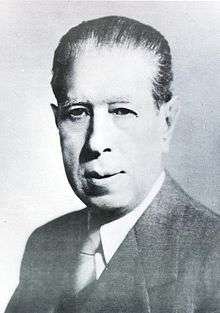Alcides Arguedas

Alcides Arguedas (La Paz, July 15, 1879 - Chulumani, May 6, 1946) was a Bolivian writer and historian. His literary work, which had a profound influence on the Bolivian social thought in the first half of the twentieth century, addresses issues related to national identity, miscegenation, and indigenous affairs. His most significant work, Bronze Race (1919), is considered one of the most influential Bolivian literary works and a precursor of the indigenism.
Background and political and diplomatic roles
Son of Fructuoso Arguedas and Sabina Diaz, he studied in the Ayacucho college and then Law and Political Science (1904) at the Universidad Mayor de San Andrés and sociology in Paris.
He began working in various forms of media as a student, beginning with Peruvian newspaper El Comercio, moving on to columns for El Diario, the short-lived Revista de América and El Mundial, and eventually became deputy editor of El Debate in 1915.[1]
As a diplomat, he was second secretary of the Legation of Bolivia in Paris (1910), where he would meet Rubén Darío and Francisco Garcia Calderon and would have as boss the ex-president Ismael Montes. Subsequently, he was sent to London.
After returning to Bolivia, he was elected deputy of the Bolivia's Liberal Party in 1916, and served as Bolivian representative to the creation of the League of Nations (1918). He also was consul general in Paris (1922) and minister plenipotentiary in Colombia (1929), where he was dismissed for criticizing the President Hernando Siles (1930).
He maintained a critical stance toward certain political administrations, for which he was removed from office, exiled, and even slapped by then-President Germán Busch. He became senator for the county of La Paz and eventually led the Liberal Party.
Under the administration of President Enrique Peñaranda, he served as Minister of Agriculture, Colonization, and Immigration (1940), and then left for Venezuela as minister plenipotentiary (1941).
Themes as a writer
Arguedas is one of Bolivia's best-known writers. His work describes the relationship between Bolivian society and its indigenous peoples, often cynically. Through his books, full of social analysis, he sought a solution for his country's permanent state of conflict. Some of the issues for which he contributed a significant amount of thought—conflicts between cultures, the complexities of mestizaje, and the sometimes violent relationship between the indigenous and creole/mestizo worlds—were later taken up by other currents of thought, including indigenismo, albeit from a different perspective.
His first literary works date from his student days, and the first book he published was Pisagua, a novel which appeared in 1903. In the subsequent year, he wrote Wata-Wara. His novelistic production would continue with Vida criolla (1912) and culminate with Raza de bronce.
His essay Pueblo enfermo ("sick people" or "sick town"), published in Barcelona in 1909, solidified his importance in Latin American letters, getting praise from major writers such as Miguel de Unamuno and Amado Nervo. However, it created controversy in Bolivia, and Franz Tamayo responded critically to his ideas in a series of editorials that would later be compiled as his book Pedagogía de la educación nacional.[2] Arguedas coined the term "radical pessimism" for his stance on indigenous issues, explaining that it came from "a mixture of fatal biological laws, historical reasons and environmental circumstances [that] have made the indigenous an atrophied or infirm race".[3] Unsurprisingly, some critics identify Arguedas with some of the more distasteful aspects of the Bolivia of his time and reject his relationship with indigenismo [4]
However, in his most important novel, Raza de bronce ("race of bronze"/"roots of bronze"), Arguedas lays out several themes that would later be instrumental in the development of Bolivian literature: the creole-mestizo oppression against indigenous peoples, their capacity to rise in the face of these abuses, the social placement of the "cholo-mestizo" (a term, now more commonly a slur, for those mestizos whose indigenous parentage exceeds their European), and the rift between creole and indigenous societies in Bolivia.
Arguedas worked on this novel almost until his death. Although he published his first edition in 1919, he continued correcting and re-editing it until he released the definitive edition in 1945. The story of Raza de bronce is an evolution of that of his second novel, Wata-Wara, which went relatively unnoticed at the time of publication. In retrospect, despite widespread criticism, it was listed by experts as one of the essential works of Bolivian literature.
Over the years, Arguedas found history to be a more direct medium for reflecting upon and interpreting Bolivian social reality. His first historical book, La fundación de la República, was published in 1920. This marked a turning point in Arguedas' life: from here, history and politics came to the fore and his work in literature became secondary.
The first volume of his Historia general de Bolivia was published two years later under the auspices of industrialist and millionaire Simon I. Patino. He completed only five of the eight projected volumes that collection, ranging from the colonial period to its violent 19th-century era of caudillismo.
Arguedas received the Rome Prize in France for his autobiographical book La danza de las sombras in 1935.
Death
He died in Chulumani, a district of La Paz.
Important works
- Pueblo enfermo 1909 (social commentary)
- Raza de bronce (1919) (novel)
- La fundación de la República (1920) (history)
- Historia general de Bolivia (1922) (history)
- Política y la Guerra del Chaco (1926) (history)
- La dictadura y la anarquía (1926) (history)
- Los caudillos bárbaros (1929) (history)
- La danza de las sombras (1934) (memoirs)
External links
References
- ↑ Paz Soldan, Edmundo (2006). Cronología de Arguedas en la edición de la Biblioteca Ayacucho de Raza de bronce. Caracas.
- ↑ Rodriguez, Huñascar. "Huñascar Rodríguez en el encuentro Somos Sur". Cochabamba.
- ↑ José Miguel Oviedo. Historia de la literatura hispanoamericana. 3. Postmodernismo, Vanguardia, Regionalismo, Alianza Editorial, Madrid, 2001, p.115
- ↑ Osorio, Óscar (2005), Alcides Arguedas: El dolor de ser boliviano